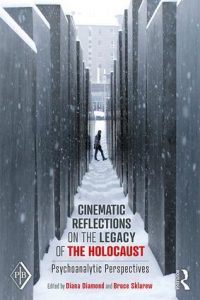Six Million and One: a Documentary
by Anna Ornstein, MD
Abstract
In addition to recording the reaction of the four Fisher siblings visiting Gussen II where their father was a 17-year-old slave laborer in WWII, the review also provides a historical and geographical context to the documentary Six Million and One. For David, the filmmaker in the family, the incentive for making the documentary was provided by their father’s diary, which he wrote two years before his death. The film records the changes in the siblings from reluctant participants to being deeply moved by what they saw and what they learned about their father’s experiences and the extent of his suffering. The inclusion of two WWII American war veterans adds poignancy and reminds the audience that the crimes committed in these places had affected not only the intended victims but also their liberators. The highlight of the documentary is pictures of the rarely seen tunnel system built deep into the Austrian Alps, primarily to assemble fighter planes. Hard labor combined with starvation diet and sub-zero temperatures claimed the lives of many thousands of Jewish men and political prisoners and made the Fisher siblings wonder: how did our father survive? A question that resonates with all survivors of this cruel and inhuman place.
In Cinematic Reflections on the Legacy of the Holocaust: Psychoanalytic Perspectives, edited by Diana Diamond and Bruce Sklarew. Routledge, 2019: 40-50. (Fulltext can be requested from the library).
Six Million and One, a 2011 Israeli documentary film by David Fisher, is available for streaming on many platforms including Amazon, YouTube, iTunes, Google Play, etc.
About the Book

An international group of psychoanalysts and film scholars address the enduring emotional legacy of the Holocaust in Cinematic Reflections on the Legacy of the Holocaust: Psychoanalytic Perspectives. Particular focus is given to how second and third generation survivors have explored and confronted the psychic reverberations of Holocaust trauma in cinema. This book focuses on how film is particularly suited to depict Holocaust experiences with vividness and immediacy.
About the Author
Anna Ornstein, MD, is a Supervising Analyst at the Boston Psychoanalytic Society and Institute, Professor Emerita of Child Psychiatry at the University of Cincinnati, a Training and Supervising Analyst at the Cincinnati Psychoanalytic Institute, a Lecturer in Psychiatry at Harvard University. She was born in Hungary in 1927. She survived deportation, ghetto imprisonment, the Auschwitz concentration camp, and the Parschnitz labor camp. In 2018, Dr. Ornstein received the Kravitz Award in recognition of her dedication to teaching about the Holocaust and the dangers of intolerance. Click here to watch her recent interview.
Previous Posts:
Lawrence J. Brown, PhD (2018). Deconstructing Countertransference. Psychoanalytic Quarterly, 87(3): 533-555.
Howard M. Katz, MD (2018). Music, Bonding, and Personal Growth: Merle Haggard’s Musical Journey toward Wholeness. Discussion of “A Place to Fall Apart, A Reading of Merle Haggard’s Music” by Richard P. Wheeler. American Imago, 75(3): 441-453.
Sarah Ackerman, PhD (2018). (How) Can We Write about Our Patients? Journal of the American Psychoanalytic Association, 66(1), 59–81.
The Boston Change Process Study Group (2018). Moving Through and Being Moved By: Embodiment in Development and in the Therapeutic Relationship. Contemporary Psychoanalysis, 54 (2): 299-321.
Fred Busch, PhD (2018). Searching for the Analyst’s Reveries. International Journal of Psychoanalysis, 99(3): 569-589.
Murray M. Schwartz, PhD (2018). Psychoanalysis in My Life: An Intellectual Memoir. American Imago, 75(2), pp. 125-152.
Click here to see a full archive of featured papers. All articles can be requested from the library.

